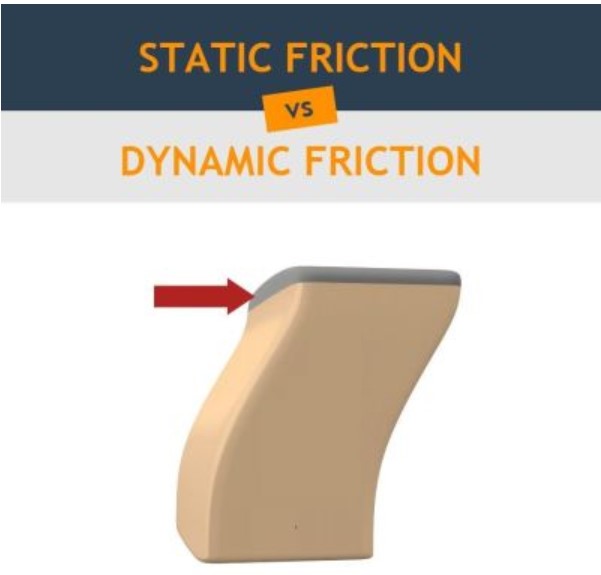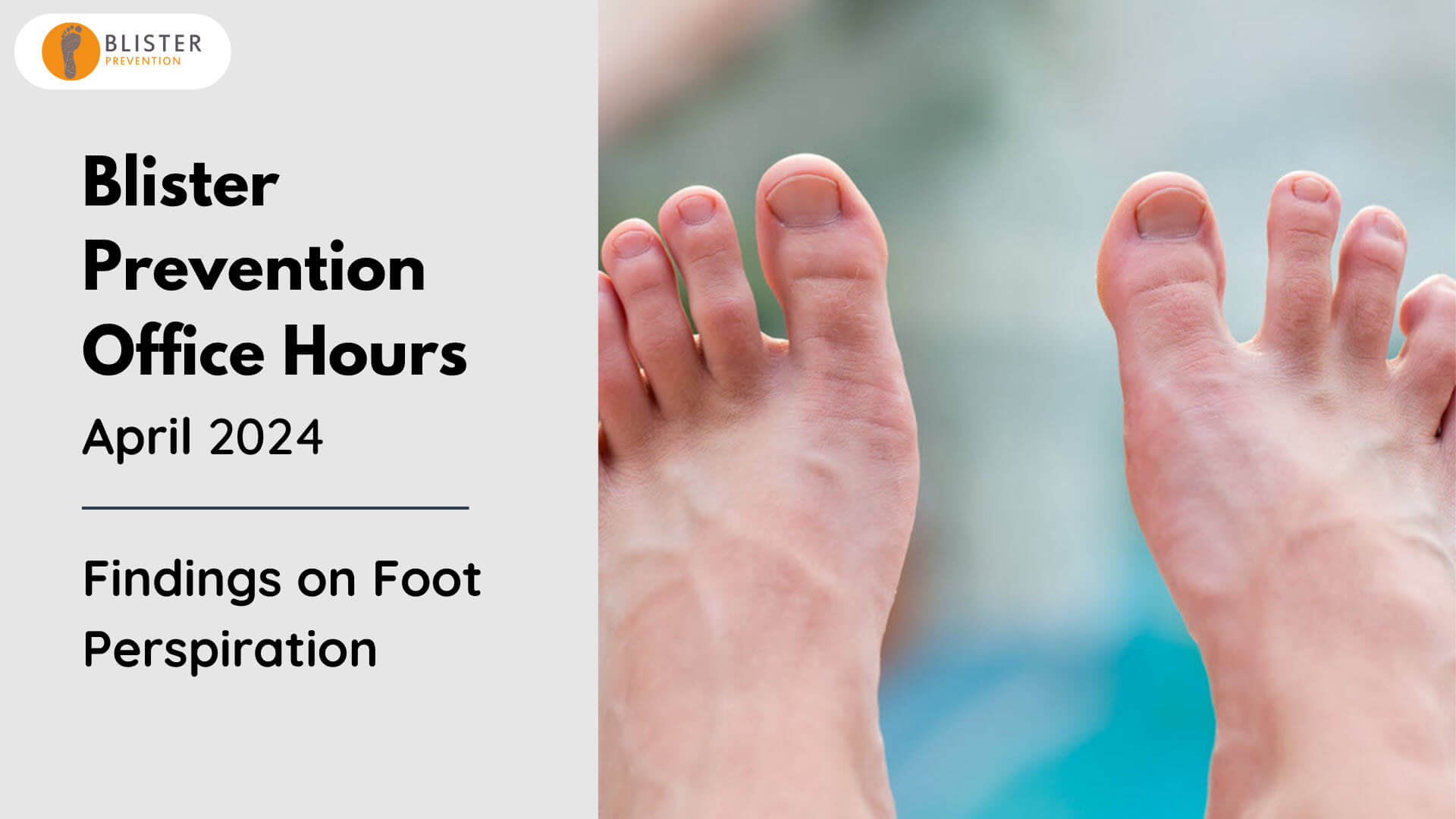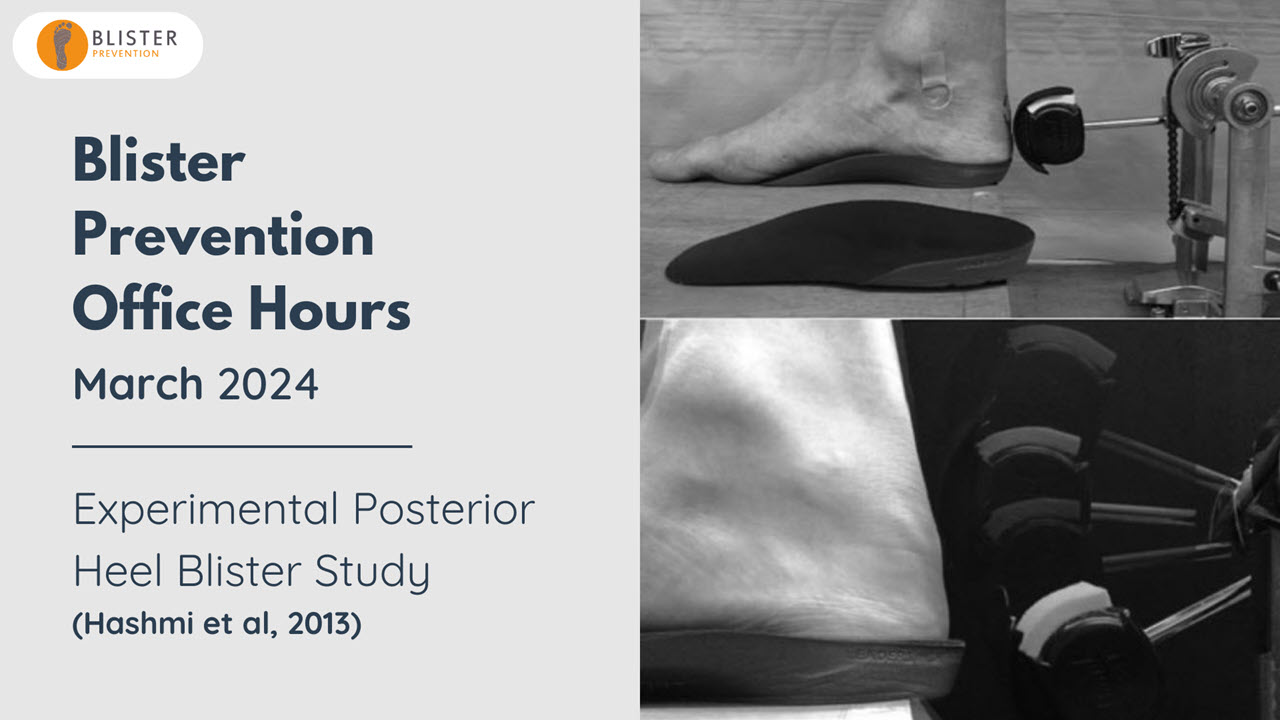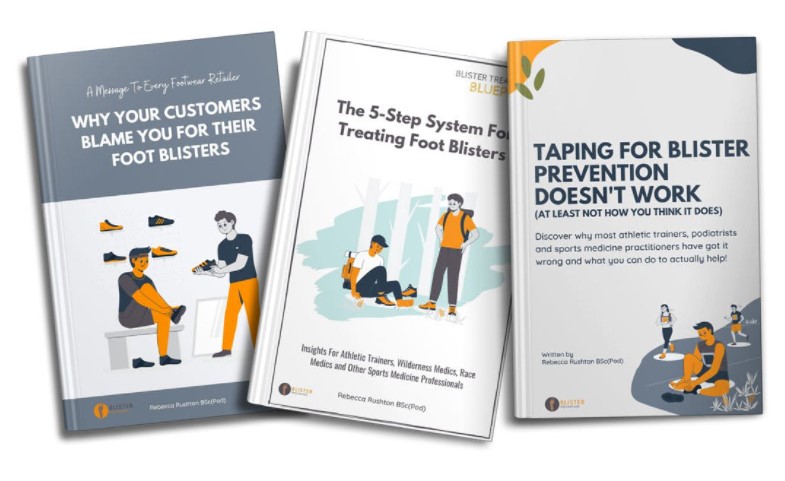What is friction? There is more than one definition of friction. And this has confused our understanding of how it is involved in friction blister formation.
The Merriam-Webster Dictionary has two definitions of friction:
- the act of rubbing one thing against another
- the force that resists relative motion between two bodies in contact
To understand how friction causes blisters, the second definition is needed. And in this article, we’re going to get even a bit more specific than that. The involvement of friction in friction blisters is easier to understand when you talk about static and dynamic friction.
Static friction vs dynamic friction
Static friction is friction that occurs between two bodies in contact with one another while they are at rest. It’s friction which prevents an object from moving while it is still.
Dynamic (or kinetic) friction is friction that opposes the movement of a body which is already in motion. It’s friction that slows or stops an object from moving.
How does friction cause blisters?
Static friction causes blisters because it results in more shear than dynamic friction. Imagining the foot as a wobbly box helps to explain:
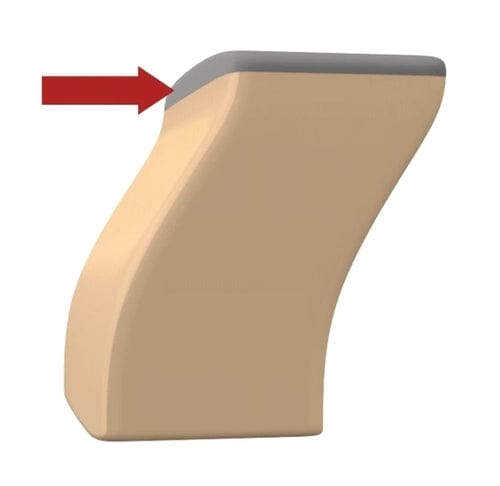
Look at this wobbly box. The movement force at the top (red arrow) is from the bones as they move back and forth. And the force of friction is what keeps the bottom of the box stationary at the bottom – in a state of static friction. Everything in between the top and the bottom is made to stretch and distort. This is shear. Blisters are an injury of repetitive shear distortions.
To stop blisters, we can either do something at the top of the wobbly box – that is, reduce bone movement. Or we can do something at the bottom of the wobbly box – reduce friction – to make it more slippery. [This is what lubricants, powders, antiperspirants, tapes, ENGO patches, moisture-wicking socks and double-socks do].
Static friction causes blisters
A state of static friction is exactly what we see with the wobbly box. There’s a movement force at the top but no movement at the bottom. Lots of shear occurs in the middle.
Now, if that wobbly box was to move at the bottom (because the movement force at the top exceeded the friction force at the bottom) that’s what you’d call a state of dynamic friction. Makes sense – static means still, dynamic means motion.
Here’s something you probably already know without realising. Have you ever tried to push a heavy box along the floor and found that a big effort is required to get it moving … but once you get it going, it’s easier to keep it moving? That’s because the force you need for the box to break free of static friction is HIGHER than that required to keep it in a state of dynamic friction.
Have a look at the table below. No matter what the combination of materials, the static COF is always higher than the dynamic (aka kinetic) COF (except Teflon on Teflon which is the same).
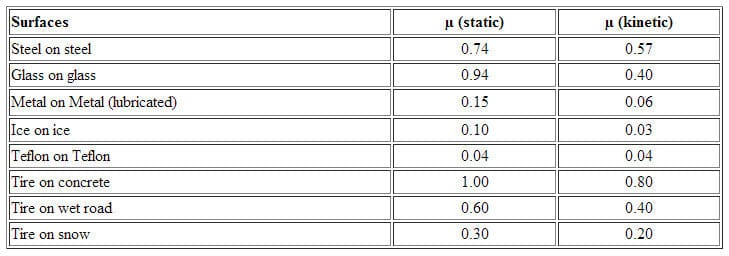
This has special significance when describing the cause and prevention of blisters. Because when static friction is high and prolonged, there is going to be more shear. The wobbly box is going to have to stretch and distort further. If we’re talking about foot blisters, that means within the skin layers.
Below is a representation of how shear develops (A). See how it increases to a maximum to what we call the shear peak. Shear builds and builds while there is a state of static friction. Now, see the dynamic section – as soon as there is movement, shear immediately reduces! So blisters form when there is a prolonged state of static friction – the longer two surfaces stay stuck together, the higher that shear is going to peak. And blisters are prevented when a state of dynamic friction occurs earlier (B) – because that gives us an earlier and hence lower shear peak.
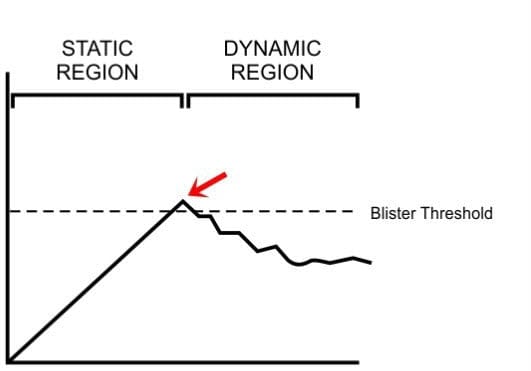
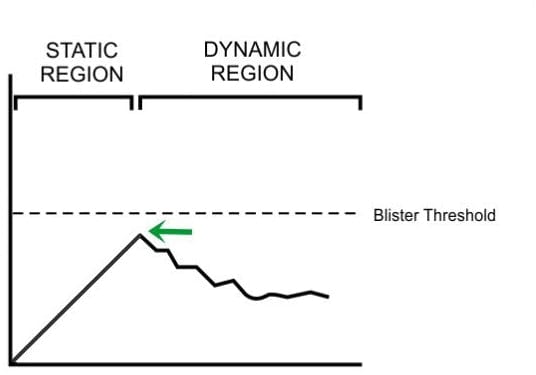
You must be thinking …
“Wait a minute, I thought rubbing causes blisters? You’re telling me that if I let rubbing go on in my shoes I can stop blisters?”
This rubbing misconception is widespread and understandable. Because it centres on the first definition of friction, mentioned at the start of this article (that friction is the act of rubbing one thing against another). Rubbing doesn’t cause blisters.
Rubbing doesn’t cause friction blisters
In fact promoting rubbing is the premise of most blister prevention strategies.
It’s not dynamic friction (rubbing) that causes highest shear. It’s static friction (before the rub) that causes it to peak highest and more likely to reach blister-causing levels. However, that’s not to say rubbing is not damaging to the skin. It all depends on the level of friction. Let me explain:
- If the COF between the skin and sock is high when there is a state of dynamic friction, that relative motion is going to be abrasive to the skin. Skin cells will be rubbed off from the top. If that keeps going, you’ll end up with a red raw sore called an abrasion (chafing on other areas of the body). Or if you already have a blister there, that abrasive motion will easily tear and dislodge your fragile blister roof and you’ll be left with a red raw sore on your foot. But the dynamic part of the process has not been responsible for forming the blister. It was already there because of the shear that resulted from static friction.
- If you had this same amount of movement between the skin and sock but this time the COF is low, that’s not going to be as abrasive to the skin. You are less likely to suffer abrasion of the blister roof.
This is key to your understanding of friction blisters!
This differentiation between static and dynamic friction, as well as high and low COF is important as the effect each has is different. Below is a summary of skin-sock permutations and the resultant effect to skin:
- State of static friction + high COF = blister-causing
- State of dynamic friction + high COF = abrasion (chafing) injury
- State of dynamic friction + low COF = blister prevention
- State of static friction + low COF = no skin injury threat
The above pertains to the skin-sock interface. It’s similar at the shoe-sock interface in that:
- A low COF provides early relative motion between the shoe and sock to minimise shear ie: blister prevention
- The difference is there is no risk of abrasion. Because in this case, the state of dynamic friction is between the skin and sock. The sock remains stuck to the skin thus protecting it.
Reducing the shear peak
When it comes to blisters, the frictional forces in play are technically described by “dry friction”. This just means where two objects are in contact with one another. Dry friction is broken down into “static friction” and “dynamic friction”.
This concept is great for describing how shear reaches its maximum (peak shear). And how that maximum might be blister-causing. It even shows what you need to do to successfully prevent blisters.
Blisters will form when shear is excessive and repetitive. Presumably, there is a threshold above which shear becomes blister-causing. That threshold is going to be different for each individual. We have no measure of it, though we do know there is such a thing as being blister prone.
A state of static or kinetic friction?
Imagine a wobbly box sitting on a table (let’s say it’s made out of jelly). If you push the wobbly box to try to slide it across the table, a small amount of force will result in no motion across the table. That’s because the force of friction between the bottom of the jelly box and the table is higher than the pushing force. This is a state of static friction. Push harder and the jelly box begins to slide across the table (yes, this is a very thick and sturdy jelly). This is a state of dynamic friction. These two states describe what is happening between the box and the table.
Now before the wobbly jelly box slides, the push causes it to distort. This distortion is shear and shear is what causes blisters. Shear increases more and more until the bottom of the box ‘breaks free’ and slides. What happens next has special relevance to blister prevention. You see as soon as the box “breaks free” and slides, research shows shear immediately gets less – see below.
Static friction vs Dynamic friction
Look at the static and dynamic regions of this graph. Now look where shear is highest. It’s at the end of the static region, just before there is sliding. The important point here is this: A state of static friction leads to the shear peak (Naylor, 1955). If static friction is prolonged, shear is more likely to peak above the blister threshold. Conversely, a state of dynamic friction reduces shear. The earlier the slide, the more likely shear will peak below the blister threshold. INTERESTING!
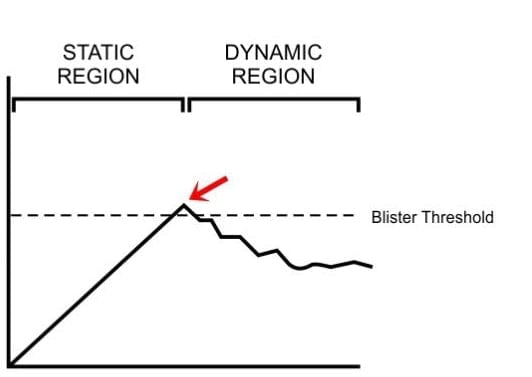
Blister prevention and shear peaks
Blister prevention is all about reducing the amplitude of shear peaks so that they fall below the blister threshold. One way to do this is by reducing friction levels. That is, to reduce the coefficient of friction (COF), making it more slippery. Going back to the wobbly box analogy, this means making it more slippery between the table and the box. When a push is applied, the box slides sooner and the shear peak is lower (see below).
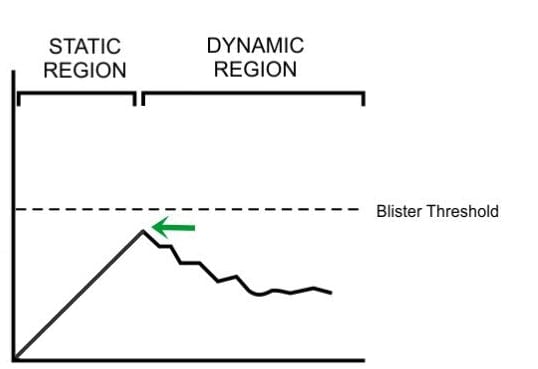
The earlier the slide, the lower the shear peak. This is exactly the effect when you use lubricants, ENGO Patches, moisture-wicking socks and other friction-reducing blister prevention strategies.
Let’s be clear in what we are hoping to achieve by reducing friction for blister prevention. By reducing the level of friction you are encouraging earlier sliding movement. That’s what you are hoping to achieve. This might be different to what you’ve previously imagined. But by reducing friction, you are encouraging an earlier slide between two surfaces.
Maintaining a state of static friction (keeping the foot still in the shoe) is not the overarching aim of blister prevention. And it is certainly not what you are trying to achieve by reducing friction. In fact the opposite is true. Shear injury is avoided by allowing an early slide. However, the nature of the slide is critical [the degree of the slide, location and area of the slide and the likelihood of added complications as a result of the slide]. This is what sets apart an average blister prevention strategy from and excellent one.
PS: The concept of static and dynamic friction has been used to describe blister causation since Naylor’s early blister research in 1955. It’s nothing new! See how far back the research goes here.

